Tom's Hardware Verdict
Tightly curved monitors like the MSI MPG Artymis 343CQR can really enhance gameplay, especially in first-person environments. With class-leading contrast, accurate out-of-box color and superb HDR, the 343CQR should be on everyone’s curved screen short list.
Pros
- +
High contrast
- +
Accurate out-of-box color
- +
Solid gaming performance
- +
1000R curve
Cons
- -
Slightly light gamma
- -
Blur reduction feature makes the screen too bright
- -
Higher input lag than some 144 Hz screens
Why you can trust Tom's Hardware
In the world of curved monitors, there are more things to consider than just screen size. Not only are there three different aspect ratios, 16:9, 21:9 and 32:9, they also come in a wide variety of curve radii. This number is expressed in millimeters like 1500R or 1800R. Larger numbers indicate less curvature. When you see 1000R, you know the curve is as extreme as it gets
MSI has jumped on the 1000R train with its MPG Artymis 343CQR. In addition to that tight curve, it sports a high-contrast VA panel running at 3440x1440 resolution with USB-C, HDR support, Adaptive-Sync and an impressive 165 Hz refresh rate worthy of competing with the best gaming monitors. Selling for a premium price ($900 as of writing), the 343CQR is a sharply focused display that is at its best when gaming -- going even as far as to include an aim magnifier for shooters.
MSI MPG Artymis 343CQR Specs
| Panel Type / Backlight | VA / W-LED, edge array |
| Screen Size, Aspect Ratio & Curve | 34 inches / 21:9 |
| Row 2 - Cell 0 | Curve radius: 1000mm |
| Max Resolution & Refresh | 3440x1440 @ 165 Hz |
| Row 4 - Cell 0 | FreeSync: 48-165 Hz |
| Native Color Depth & Gamut | 10-bit (8-bit+FRC) / DCI-P3 |
| Row 6 - Cell 0 | DisplayHDR 400, HDR10 |
| Response Time (MPRT) | 1ms |
| Brightness (mfr) | SDR: 350 nits |
| Row 9 - Cell 0 | HDR: 550 nits |
| Contrast (mfr) | 3,000:1 |
| Speakers | None |
| Video Inputs | 1x DisplayPort 1.4 |
| Row 13 - Cell 0 | 2x HDMI 2.0 |
| Row 14 - Cell 0 | 1x USB-C |
| Audio | 3.5mm headphone output |
| USB 3.2 | 1x up, 2x down |
| Power Consumption | 32.6w, brightness @ 200 nits |
| Panel Dimensions WxHxD w/base | 31.3 x 16.5-20.5 x 12.4 inches (795 x 419-521 x 315mm) |
| Panel Thickness | 6.5 inches (165mm) |
| Bezel Width | Top/sides: 0.4 inch (9mm) |
| Row 21 - Cell 0 | Bottom: 0.9 inch (22mm) |
| Weight | 20.2 pounds (9.2kg) |
| Warranty | 3 years |
The 343CQR is all about gaming with support for AMD FreeSync from 48-165 Hz. It’s not G-Sync Compatible-certified, but we still got Nvidia G-Sync to work (see our How to Run G-Sync on a FreeSync Monitor article for instructions).
MSI’s specs sheet includes nearly 85% coverage of the DCI-P3 color gamut. You’ll be using that gamut for all content, SDR and HDR alike, because there is no sRGB mode available.
MSI designed the 343CQR with consoles in mind too. It will accept 4K resolution signals and down-convert them to 3440 x 1440 resolution. The 343CQR is also the first monitor we’ve seen with HDMI CEC (Consumer Electronics Control). Originally developed to support universal remotes, the CEC implementation in this monitor is designed to sense whether the incoming signal is coming from a PC or a console and adjust its picture mode based on designated profiles. The feature supports both PlayStation and Nintendo Switch.
Assembly and Accessories of MSI MPG Artymis 343CQR
To assemble the MSI MPG Artymis 343CQR, the panel and upright are mated with four fasteners, so you’ll need to have a Phillip’s head screwdriver handy. Next, you attach the base with a captive bolt. The resulting package is rock-solid and shows impressive build quality. It certainly meets the standard one expects for the price.
Bundled cables include IEC for the internal power supply, DisplayPort, HDMI and USB. A small snap-on cover hides the panel’s mounting hardware. And if you’d rather use a monitor arm, the bolt holes are in a 100mm VESA pattern with large-head bolts included. In a nice touch, a small hook snaps onto the bottom of the panel to help manage your best gaming mouse’s cable.
Get Tom's Hardware's best news and in-depth reviews, straight to your inbox.
MSI MPG Artymis Product 360

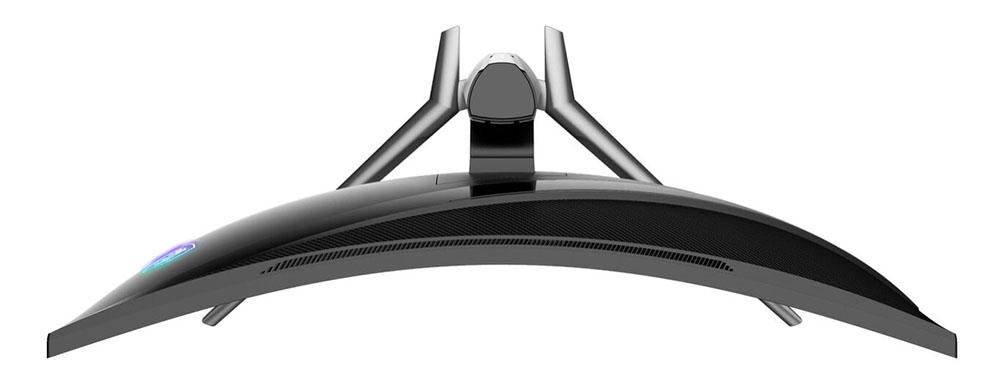
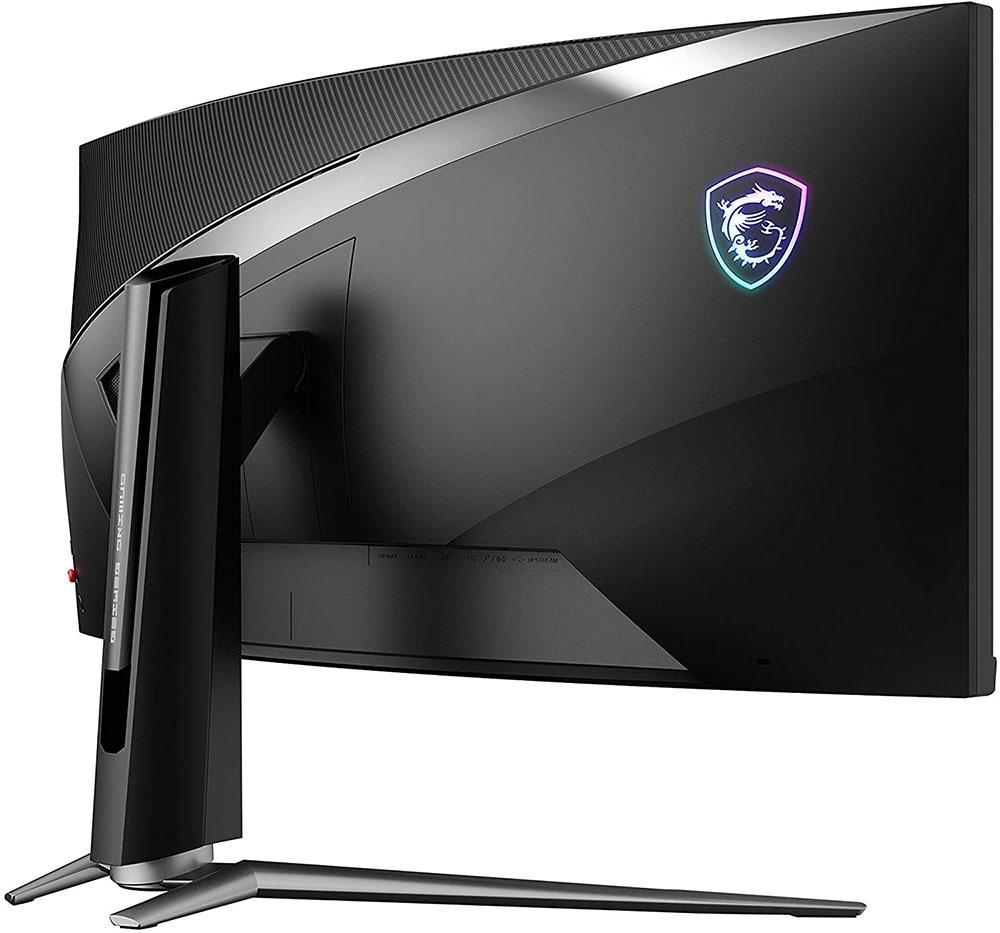

From the front, the MSI MPG Artymis 343CQR is all business with a thin flush bezel around the top and sides and a molded strip across the bottom adorned only with a small MSI logo. A tiny LED appears red in standby mode and white when the power’s on. Around the back right is a joystick and two buttons. One activates the Gaming OSD (on-screen display) app, and the other toggles power.
The upright is very solid with a stiff-moving 4-inch height adjustment. You also get 30 degrees swivel to both sides and 5/20 degrees tilt. There isn’t even a hint of slop or wobble. A small hole helps tidy up cables. The base is solid metal with thin legs that go more than 1 foot deep. That, combined with the fact that the panel’s 6.5-inch thick means you’ll need a bit of extra desktop space to accommodate the 343CQR.
From the top, you can see the 1000R curvature clearly. That radius means that if you made a circle from 343CQRs, it would be just two meters in diameter. If you have the room for three of them, they’ll wrap around almost 180 degrees. They would make a great flight simulator or, perhaps, a solid solution for a Zwift (cycling virtual training app) setup.
The back of the MSI MPG Artymis 343CQR is styled nicely with a variety of different textures and an RGB effect that shows as a strip and MSI shield graphic with a dragon. The color breaths gently through different shades. You can turn it on and off in the OSD and control it ever further with the Gaming OSD app. You can also sync up the lighting effect with that of other MSI products that support the vendor’s Mystic Light-branded RGB. That way, you can create a custom light show with everything working in concert.
The input panel includes two HDMI 2.0 ports that support refresh rates up to 100 Hz with Adaptive-Sync and HDR. Meanwhile, the DisplayPort 1.4 and USB-C inputs accept 165 Hz signals, also with HDR and Adaptive-Sync. There are no built-in speakers, but you get a 3.5mm audio port for headphones.
OSD Features of MSI MPG Artymis
Pressing the joystick brings up the MSI MPG Artymis 343CQR’s OSD,which is divided into seven sub-menus. There are plenty of gaming features as well as most of what you’ll need for calibration.
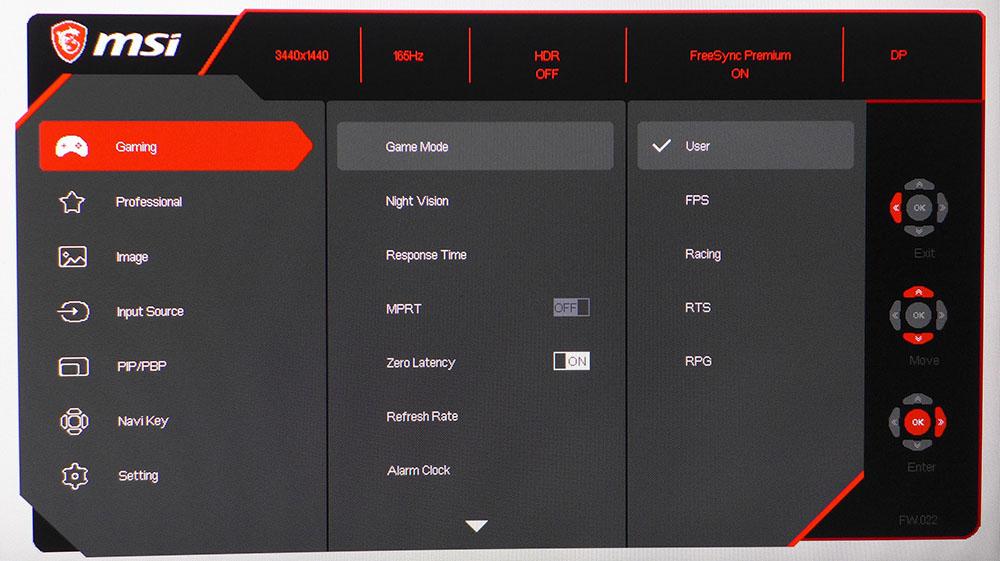
The Gaming menu offers five picture modes. Four are game genre-specific, and there’s also the default mode, User. User’s the mode to pick because it delivers solid accuracy with no need for calibration. There are a few minor flaws, but the 343CQR definitely makes our Calibration Not Required list.
The Night Vision option is a shadow detail enhancer. We didn’t need it because the monitor’s black levels are both deep and richly detailed. Response Time is a three-level overdrive. Fast, the middle setting, is best. Next, MPRT is a backlight strobe that reduces motion blur and cancels out Adaptive-Sync.
It also pegs the brightness at over 860 nits, which is unusual. You can reduce this with the contrast control, but that removes much of the picture’s depth and quality. We recommend sticking with Adaptive-Sync and leaving MPRT off. Finally, Zero Latency should always be turned on for the lowest possible input lag.
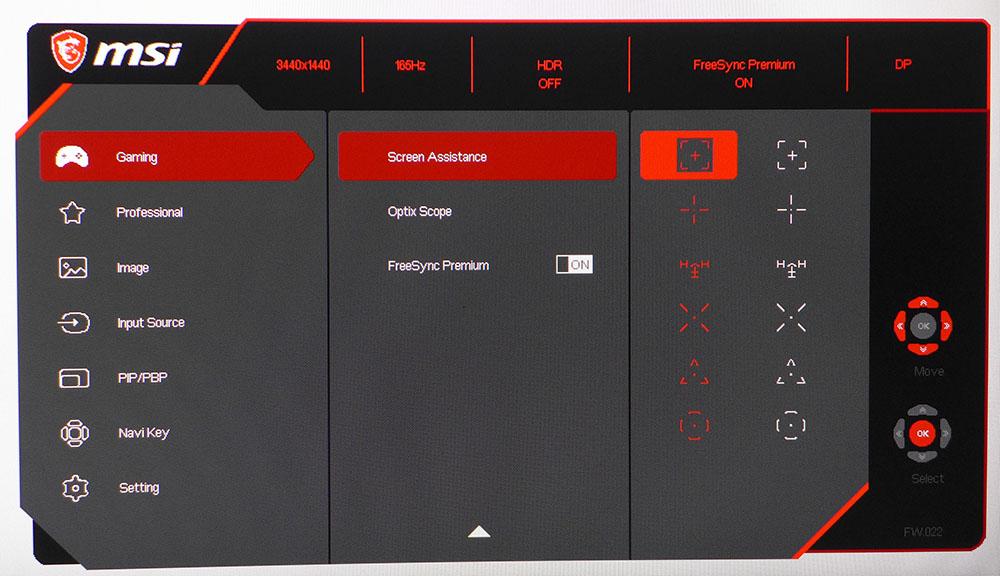
Additional features include a frame rate indicator, alarm clock, aiming points and an Optix Scope feature. This is geared at fans of first-person shooters and lets you magnify the area underneath your crosshair in multiple levels using hot keys. As this will take some finessing to execute smoothly and without slowing down your gameplay, it won’t be for everyone.
The OSD will always show you the MSI MPG Artymis 343CQR’s signal status at the top with resolution, refresh rate, HDR status, FreeSync status and the active video input.
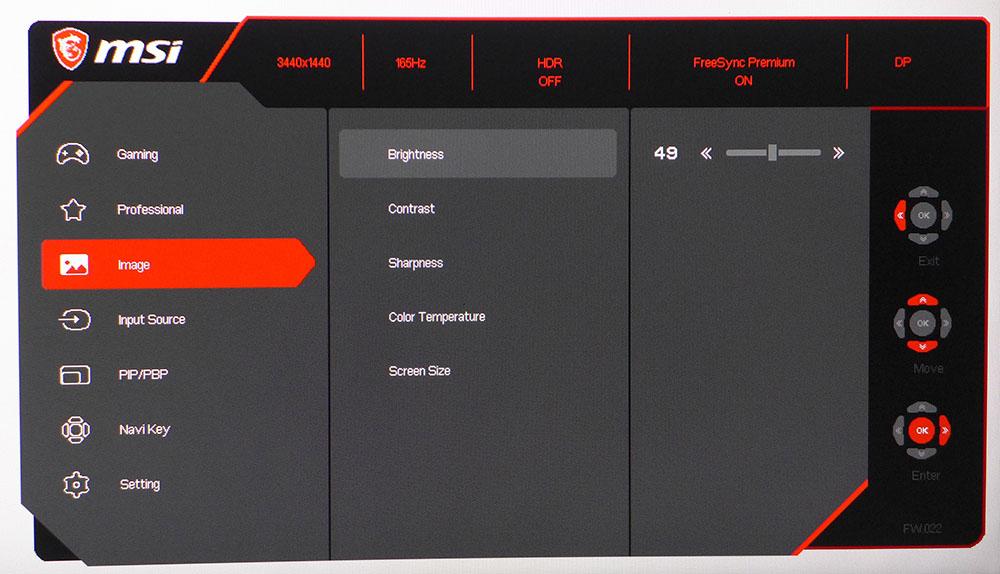
The Image menu offers three color temperature presets, plus a User mode. Normal is the default and best choice. We were unable to make a visual improvement to the color temp with calibration. The test numbers show a tiny gain but not one that can be seen with the naked eye. The only thing we wished for was a gamma control. The default luminance curve is a tad light, though that’s somewhat mitigated by the 343CQR’s extremely high contrast.
Calibration Settings of MSI MPG Artymis 343CQR
You can simply unpack the MSI MPG Artymis 343CQR, plug it in and enjoy. The image is very accurate by default -- even the brightness is already set close to 200 nits in the User picture mode. We attempted a calibration and made no visible improvement.
Our settings are below if you want to try them. Note that in the User color temp, the RGB sliders start at 50%, which reduces brightness by roughly that amount. We turned them all up to 100%, then adjusted from there to achieve maximum dynamic range.
| Picture Mode | User |
| Brightness 200 nits | 49 |
| Brightness 120 nits | 6 (min. 109 nits) |
| Contrast | 70 |
| Color Temp User | Red 100, Green 93, Blue 93 |
HDR signals lock out all picture controls. You can still access the modes, but changing them does not affect the image. HDR grayscale runs a tad red, but the EOTF is spot-on, as is the color tracking. The 343CQR also uses dynamic contrast to achieve tremendous contrast for HDR content.
Gaming and Hands-on with MSI MPG Artymis 343CQR
At 1000R, the MSI MPG Artymis 343CQR is as curvy as a gaming monitor gets today. At first, we noticed a little image distortion when working in productivity apps, like word processors and spreadsheets. However, we got used to the look after a short time.
When browsing the web, that distortion became unnoticeable. The monitor’s image is sharp and contrast-y enough to overshadow any horizontal line curvature. It’s best to set the panel exactly vertical with no back or forward tilt. By adjusting the height so our eyes were centered, it made all parts of the screen equidistant from the body. The 343CQR is perfectly usable for workday tasks.
Color was nicely balanced with slightly more than sRGB saturation but not so much that it looked unnatural. MSI has tuned the gamut so it renders SDR content more accurately without the need to switch color spaces, a capability the MSI MPG Artymis 343CQR lacks. When HDR was on, color looked far more vibrant, as it should. This is one of the few monitors that you could leave in HDR mode all the time for Windows apps. Brightness is reasonable with the highest levels reserved only for small highlights.
The monitor also supports 10-bit color, though the panel uses Frame Rate Conversion to achieve this. Despite the internal upconversion, we didn’t see any banding artifacts.
Gaming tests started with our usual trip through Tomb Raider, which clipped along at a sprightly 165 fps on a Radeon RX 5700 XT and GeForce RTX 3090. Both FreeSync and G-Sync worked without a hitch. The MSI MPG Artymis 343CQR’s middle overdrive setting, Fast, struck the best balance between ghosting and blur reduction. The MPRT backlight strobe feature also worked well at reducing blur without artifacts but at the cost of a very bright and overly harsh image. Playing games at over 800 nits peak grew tiring after a short time.
Engaging HDR for a few hours of Call of Duty: WWII proved to be a singular experience. The MSI MPG Artymis 343CQR nears equalling a FALD display when it comes to HDR contrast and color. Every hue, down to the murkiest greens and browns, leapt from the screen. Black levels seemed almost OLED-like in their depth and detail, offset by perfectly balanced highlight areas. Color accuracy was also top-notch. Though we noted a slight red tint during the grayscale tests, it did not affect games or movies we played. This is one of the best HDR monitors we’ve seen in a while.
If you download MSI’s Dragon Center software, you can also use the 343CQR's Sound Tune feature which uses “AI calculations” to block out background noise coming through a plugged in headset. Since it requires software and many of the best gaming headsets include similar tech on their own, its usefulness will vary depending on the gamer.
Another unique feature comes in what MSI calls Mobile Projector. It lets you display your phone’s screen in a 5:9 column on the side of the monitor. Although having your phone on your computer screen could generally be distracting, if you have a specific task that requires using both your smartphone and PC, this could come in handy.

Christian Eberle is a Contributing Editor for Tom's Hardware US. He's a veteran reviewer of A/V equipment, specializing in monitors. Christian began his obsession with tech when he built his first PC in 1991, a 286 running DOS 3.0 at a blazing 12MHz. In 2006, he undertook training from the Imaging Science Foundation in video calibration and testing and thus started a passion for precise imaging that persists to this day. He is also a professional musician with a degree from the New England Conservatory as a classical bassoonist which he used to good effect as a performer with the West Point Army Band from 1987 to 2013. He enjoys watching movies and listening to high-end audio in his custom-built home theater and can be seen riding trails near his home on a race-ready ICE VTX recumbent trike. Christian enjoys the endless summer in Florida where he lives with his wife and Chihuahua and plays with orchestras around the state.
-
braitBR You guys say there is no sRGB mode, but the manual lists it under the professional picture options.Reply
EDIT: yes, there is. Why does the review say there isn't?